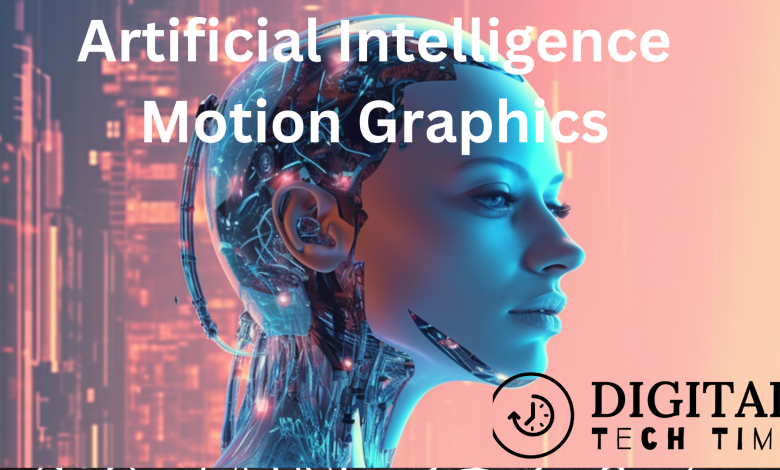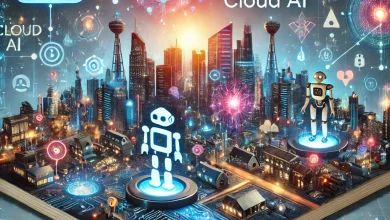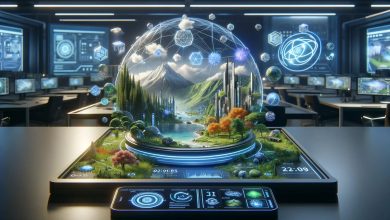Artificial Intelligence Motion Graphics: Revolutionizing Visual Content

Understanding Artificial Intelligence Motion Graphics
Artificial intelligence (AI) is revolutionizing the world of motion graphics. AI is a branch of computer science that enables machines to perform tasks that typically require human intelligence, such as image and speech recognition, decision making, and language translation. In the context of motion graphics, AI is used to create more realistic, lifelike, and complex animations and effects.
AI algorithms can analyze and understand the content of a video or image and apply various effects and animations to it. For example, AI can identify the movement of a person or object in a video and apply motion tracking to it, creating a more seamless and natural-looking animation. AI can also analyze the colors and lighting in an image and apply color grading and lighting effects to enhance the visual impact.
AI is also used to automate repetitive and time-consuming tasks, such as rotoscoping, which involves manually tracing around objects in a video frame by frame. With AI, this process can be automated, saving time and increasing efficiency for motion graphics designers.
Another use of AI in motion graphics is the creation of generative art, which involves using algorithms to create unique and complex patterns and designs. AI can analyze data and patterns to generate new and creative designs that would be difficult or impossible for a human to create.
Overall, AI is transforming the world of motion graphics by enabling designers to create more sophisticated and realistic animations and effects while also increasing efficiency and creativity.
History and Evolution of AI in Motion Graphics
Artificial Intelligence (AI) has been used in motion graphics for several years. AI has been used to create realistic, lifelike, and complex graphics. The following are some notable milestones in the history and evolution of AI in motion graphics:
- In 1950, Claude Shannon built the “Theseus,” a remote-controlled mouse that could navigate a labyrinth and remember its course. This was the first known AI system.
- In the 1970s, a computer-generated film called “Future world” was released. It featured the first use of computer-generated 3D graphics in a motion picture.
- In the 1980s, Pixar Animation Studios was founded, and they began using computers to animate their films. Their first film, “Toy Story,” was released in 1995 and was the first feature-length film to be entirely computer-animated.
- In the 2000s, AI began to be used more extensively in motion graphics. AI algorithms were used to create realistic simulations of water, fire, and other natural phenomena.
- In recent years, AI has been used to create more complex and realistic characters and environments. AI algorithms can now generate 3D models of characters and landscapes based on real-world data.
AI has come a long way since the first AI system was built in 1950. Today, AI is used extensively in motion graphics, and it has revolutionized the industry. AI algorithms can create graphics that are more realistic, lifelike, and complex than ever before. As AI technology continues to evolve, we can expect to see even more impressive graphics in the future.
Techniques and Tools in AI Motion Graphics
Generative Adversarial Networks
Generative Adversarial Networks (GANs) are a type of neural network that have been used in motion graphics to generate new and unique content. GANs work by pitting two neural networks against each other: a generator and a discriminator. The generator creates new content, while the discriminator evaluates the content and provides feedback to the generator. Over time, the generator learns to create more realistic and convincing content.
In motion graphics, GANs can be used to create new animations, transitions, and special effects. For example, GANs can be used to generate realistic fire or water simulations, or to create new character animations.
Recurrent Neural Networks
Recurrent Neural Networks (RNNs) are a type of neural network that can process sequences of data. RNNs are well-suited for motion graphics because they can process and analyze a sequence of frames to create smooth and realistic animations.
RNNs can be used in motion graphics to create animations that follow a specific path or trajectory. For example, RNNs can be used to create animations of a character walking or running, or to create animations of a camera moving through a scene.
Deep Learning
Deep Learning is a subfield of machine learning that uses neural networks with many layers to learn and analyze complex patterns in data. Deep Learning has been used in motion graphics to create more realistic and detailed animations.
Deep Learning can be used in motion graphics to create animations that are more lifelike and convincing. For example, Deep Learning can be used to create realistic facial expressions or to animate complex objects like cars or airplanes.
In conclusion, AI techniques and tools like GANs, RNNs, and Deep Learning are revolutionizing motion graphics by enabling designers to create more realistic, lifelike, and complex animations.
Applications of AI in Motion Graphics
Artificial Intelligence (AI) is rapidly transforming the field of motion graphics. From creating realistic animations to reducing the time and effort required for post-production work, AI is being used in various applications related to motion graphics. In this section, we will explore some of the most common applications of AI in motion graphics.
Film and Television
AI is being used in the film and television industry to create realistic animations, special effects, and 3D models. It is also being used to automate the process of rotoscoping, which is a technique used to create a matte for an element on a live-action plate. AI algorithms can analyze the footage and automatically create a matte, saving a lot of time and effort for the artists.
AI is also being used to improve the quality of visual effects. For example, AI algorithms can be used to remove unwanted elements from a shot, such as wires or rigs, without requiring manual intervention. This can save a lot of time and effort for the artists, allowing them to focus on more creative tasks.
Video Games
AI is being used in the video game industry to create realistic animations, characters, and environments. AI algorithms can analyze motion capture data and create realistic animations for characters and objects. They can also be used to generate procedural content, such as terrain and environments, which can save a lot of time and effort for the artists.
AI is also being used to improve the quality of gameplay. For example, AI algorithms can be used to create intelligent and adaptive enemies, which can make the gameplay more challenging and engaging for the players.
Advertising and Marketing
AI is being used in the advertising and marketing industry to create engaging and personalized content. AI algorithms can analyze user data and create personalized ads and content based on their preferences and behavior. This can help companies to improve their engagement and conversion rates.
AI is also being used to automate the process of creating marketing content. For example, AI algorithms can analyze a script and automatically generate a storyboard, saving a lot of time and effort for the artists.
In conclusion, AI is being used in various applications related to motion graphics, from creating realistic animations to automating the post-production process. As AI technology continues to evolve, we can expect to see more innovative applications of AI in motion graphics in the future.
Challenges and Limitations of AI in Motion Graphics
While Artificial Intelligence (AI) has made significant advancements in the field of motion graphics, there are still several challenges and limitations that need to be addressed.
Lack of Creativity
One of the biggest challenges of using AI in motion graphics is the lack of creativity. AI can only generate designs based on pre-existing data and patterns. It lacks the ability to create something completely new and unique, which is a crucial aspect of motion graphics. While AI can assist in the creative process, it cannot replace the creativity of a human designer.
High Cost
Another major limitation of AI in motion graphics is the high cost of implementation. AI technology requires a significant investment in hardware, software, and training. Small businesses and independent designers may not have the resources to invest in AI technology, which limits their ability to compete with larger companies that can afford to use AI.
Limited Customization
AI technology is designed to create designs based on pre-existing data and patterns. This means that it may not be able to create custom designs that are specific to a particular project or client. This limitation can be a significant challenge for designers who need to create unique and customized designs for their clients.
Limited Understanding of Context
AI technology can create impressive designs, but it lacks the ability to understand the context in which those designs will be used. For example, an AI-generated design may look great on a computer screen, but it may not be suitable for a billboard or other large-scale display. Designers need to consider the context in which their designs will be used, which is something that AI technology cannot do on its own.
Conclusion
While AI has made significant advancements in the field of motion graphics, it still has several challenges and limitations that need to be addressed. Designers need to understand the strengths and limitations of AI technology and use it as a tool to assist in the creative process rather than a replacement for human creativity.
Future Trends in AI Motion Graphics
As AI continues to advance, it is expected to play an increasingly important role in the field of motion graphics. Here are some potential future trends in AI motion graphics:
Personalization
One of the most exciting aspects of AI in motion graphics is the ability to personalize content for individual viewers. AI algorithms can analyze viewer data to create customized graphics that are tailored to each viewer’s preferences and interests. This could lead to more engaging and effective marketing campaigns, as well as more immersive entertainment experiences.
Realism
With the help of AI, motion graphics are becoming more realistic and lifelike. AI algorithms can generate complex animations and dynamic transitions that mimic real-world physics and movements. This could lead to more immersive virtual reality experiences, as well as more convincing special effects in films and television shows.
Efficiency
AI can also make motion graphics production more efficient. AI algorithms can automate certain tasks, such as rotoscoping or color correction, which can save time and reduce costs. This could lead to faster turnaround times for projects and more affordable pricing for clients.
Creativity
AI tools for motion graphics can help designers push the boundaries of their creativity. These tools can generate visually stunning effects and complex animations that would be difficult or impossible to create manually. This could lead to more innovative and eye-catching designs in advertising and entertainment.
Overall, the future of AI in motion graphics looks bright. As AI continues to advance, we can expect to see more personalized, realistic, efficient, and creative motion graphics in the years to come.
Frequently Asked Questions
What are some examples of AI animation generators?
AI animation generators are software programs that use artificial intelligence to create motion graphics. Some popular examples of AI animation generators include Adobe After Effects, Blender, and Cinema 4D. These programs use algorithms and machine learning to generate animations that are often more complex and realistic than those created manually.
How can AI be used to create motion graphics?
AI can be used to create motion graphics in a variety of ways. One of the most common methods is through the use of machine learning algorithms that analyze large amounts of data to identify patterns and generate animations based on those patterns. AI can also be used to automate certain aspects of the motion graphics creation process, such as keyframe animation and camera movement.
Is there an AI that can generate talking animations?
Yes, there are AI programs that can generate talking animations. One example is Lyrebird, which uses deep learning algorithms to analyze speech and generate realistic voiceovers. Another example is Adobe’s Project Vo Co, which uses machine learning to analyze audio recordings and generate new speech that sounds like the original speaker.
How is AI being used in radical motion graphics?
AI is being used in radical motion graphics to create animations that are more complex and visually stunning than ever before. For example, some AI programs can generate 3D models and animations based on real-world objects and environments, allowing for more realistic and immersive graphics. AI can also be used to automate certain aspects of the motion graphics creation process, such as lighting and shading.
What are some benefits of using AI in 3D animation?
Using AI in 3D animation can have several benefits. For example, AI can help reduce the time and cost required to create complex animations by automating certain aspects of the process. AI can also help improve the quality and realism of the animations by generating more accurate physics simulations and lighting effects.
Can AI completely replace the need for human motion graphics designers?
While AI can automate certain aspects of the motion graphics creation process, it is unlikely to completely replace the need for human designers. Human designers bring a unique perspective and creativity to the process that cannot be replicated by AI. Additionally, AI is still limited by its programming and cannot match the flexibility and adaptability of human designers.





